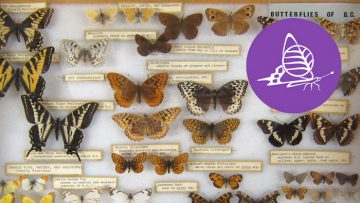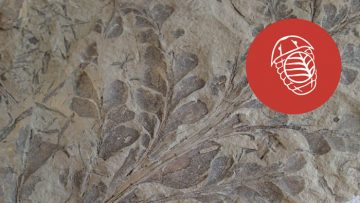Fall in love with the diversity of life as you explore over 500 natural history exhibits, showcasing myriad fossils, shells, insects, fungi, mammals, birds, reptiles, amphibians, and plants from around British Columbia and the world.
Our specimens are organized in six collections. These collections are the centrepiece of the Beaty Biodiversity Museum and were each started by a different collector, some as early as the 1910s. Over the decades, the collections were added to by myriad researchers, and grew to contain over two million specimens. In 2001, researchers at the Biodiversity Research Centre and within the departments of Botany and Zoology envisioned a building that would facilitate interdisciplinary work on biodiversity, house UBC’s biodiversity researchers and collections, and contain a public natural history museum.
If you are interested in using our collections for research, please visit our research pages.

Cowan Tetrapod Collection
Tetrapods are vertebrate animals that have, or possess ancestors that had, four limbs. The tetrapods are amphibians, reptiles, birds, and mammals, including humans.
The Cowan Tetrapod Collection was founded in 1943, but the oldest specimen dates from 1849. With over 40,000 specimens representing over 2,500 species, the collection is the second-largest scientific collection of birds, mammals, reptiles, and amphibians in British Columbia. It holds large, representative samples of nearly all species—and most subspecies—of British Columbia’s terrestrial vertebrates and marine mammals. Important specimens representing global biodiversity are also housed here including the rare red panda, endangered Vancouver Island marmot, and even extinct species, such as the passenger pigeon.
At one time called the Cowan Vertebrate Museum, the collection was named after the museum’s first curator, Dr. Ian McTaggart-Cowan. In its early years, it grew through important donations such as the Kenneth Racey collection of over 4,200 birds and mammals, the H.R. MacMillan ornithological collection, and the zoological collections of W.S. Maguire and J. Wynne. Although mainly used for research, the collection also holds teaching specimens used by educators, artists, and others throughout the Lower Mainland.
 Marine Invertebrate Collection
Marine Invertebrate Collection
Marine invertebrates encompass the entire evolutionary tree of animals, except for land-dwelling arthropods, like insects and arachnids, and animals with backbones, such as fishes and tetrapods.
The Marine Invertebrate collection was started in the 1940s with alcohol-preserved specimens collected by Dr. C. McLean Fraser and Dr. Ian McTaggart-Cowan. Primarily used for teaching, the collection eventually grew to several thousand specimens representing the major lineages of invertebrate animals.
In 2006, Kelly Norton donated the Alice Stein collection, consisting of thousands of shells and corals. The Marine Invertebrate Collection was further expanded in 2007 with a large donation of shells from Evelyn Hebb Killam. Both contributions represent mostly tropical species and include some spectacular examples of global marine biodiversity, such as giant clams and some rare species of cowries.
 Herbarium
Herbarium
A herbarium is a taxonomically and geographically organized collection of preserved plants, algae, lichens, and fungi.
In 1912 the Herbarium was located on West Pender Street, Vancouver, and formed part of the provincial government’s Botanical Office. John Davidson, the Provincial Botanist at that time, negotiated its relocation to UBC in 1916. Today, it holds more than 650,000 specimens, some dating back as far as 1804, and is the largest herbarium in Canada, west of Ottawa. Botanical researchers refer to our specimens to help identify the plants they work on, describe new species, and track changes in diversity in space and time. The specimens in the herbarium are also used to help train the next generation of Canadian botanists.
Herbarium collections traditionally include the land plants—mosses, ferns, conifers, flowering plants, and their relatives—as well as algae, lichens, and fungi. This odd assemblage represents older notions of the botanical world. If we compare this diversity to the different groups of animals in the museum, it would be equivalent to grouping fish, tetrapods, insects, and marine invertebrates into one collection. We also now know that lichens are really an emergent property of fungi and algae living in intimate relation with one another and that fungi are more closely related to animals than to plants —they’re not plants at all!
 Spencer Entomological Collection
Spencer Entomological Collection
Entomology is the study of insects. This can also include arachnids and other terrestrial invertebrates.
The Spencer Entomological Collection holds specimens from as far back as the 1830s. Dr. George J. Spencer began the collection in the 1920s, but it wasn’t formally established at UBC until 1953. By the time he left in 1958, the collection had grown to over 300,000 specimens. Dr. Geoffrey G.E. Scudder served as the collection’s director from 1958 to 1999. Both Dr. Spencer and Dr. Scudder were avid collectors and expanded the collection greatly, particularly its holdings of fleas, lice, and the true bug families Lygaeidae and Miridae. Dr. Wayne Maddison became the collection’s director in 2003 and enlarged the collection of jumping spiders into one of the world’s best through field work in tropical and temperate regions.
The collection today holds over 600,000 specimens and is the second-largest entomological collection in western Canada. It contains numerous holotype specimens, such as the planthopper Achrotile distincta, which Dr. Scudder discovered in the Cariboo-Chilcotin in 1959 and described as a new species in 1963. It also holds historical specimens of species that have disappeared from the province, such as the viceroy butterfly (Limenitis archippus), last collected in Lillooet in 1930.
Over half a million pinned specimens, 75,000 alcohol-preserved specimens and 25,000 specimens on slides showcase BC and the Yukon’s spectacular insect diversity. Past collectors’ particular projects have shaped the collection, and have resulted in particularly strong holdings of Hemiptera (true bugs), Odonata (dragonflies and damselflies), Siphonaptera (fleas) and Anoplura and Mallophaga (lice).
 Fish Collection
Fish Collection
Fish are animals that live in water, respire through gills, and have skeletons made of bone or cartilage.
The Fish Collection was begun by Dr. C. McLean Fraser, the first head of UBC’s Department of Zoology. Some specimens date back as far as 1904, but cataloguing didn’t begin until 1945. Dr. Murray Newman was the collection’s first curator, and Dr. Wilbur Clemens, G.V.Wilby, Dr. Casimir Lindsey, Dr. Norman Wilimovsky, and Dr. J. Donald McPhail each expanded the collections greatly over the decades.
Today, the collection holds over 800,000 specimens and over 50,000 DNA and tissue samples, making it the third-largest fish collection in Canada. The collection holds 11 holotype specimens, original specimens that were used to describe new species. It also contains representatives of what may be the youngest fish species on Earth: pairs of stickleback species that evolved only recently in British Columbia’s lakes.
The collection has been used in environmental assessments, conservation efforts, and numerous research projects, as well as in educating and training some of Canada’s leading fish biologists. Its specimens have also been used to document regime shifts in the Bering Sea, the formation of new species, and the extinction of others.
 Fossil Collection
Fossil Collection
Fossils are traces of organisms preserved in rocks and minerals.
The Fossil Collection was started in 1924 by Dr. Merton Yarwood Williams, who was a founding member of what was then UBC’s Department of Geology. The collection began with the purchase of specimens from W.J. Sutton, a local mining engineer. It expanded substantially in the 1970s and 1980s with the curatorial efforts of Joe Nagel, curator from 1971 to 1995. The Fossil Collection is part of the Pacific Museum of Earth, Department of Earth, Ocean and Atmospheric Sciences, UBC.
The collection contains over 20,000 specimens, ranging from recent shells and Neanderthal stone tools to traces of bacterial mats, called stromatolites, that represent some of the oldest evidence of life on Earth. The collection includes specimens about 505 million years old from the famous Burgess Shale in eastern British Columbia, as well as fossils from all over the world.
